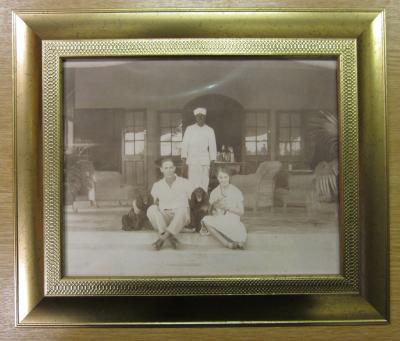An Exhibition Dilemma: From Suits to Saris
In this photograph, we see a man standing behind two people sitting on a verandah. The sitting man is flanked by two dogs. Rattan chairs are in the background, and potted palms to the side.
Many people who look at this photo will see a colonial photograph from India, in which two British people sit in front of their member of domestic staff. This Indian man wears a servant’s uniform typical of that period in India: a smart uniform comprising of a dhoti (Indian trousers), a turban, and a single-breasted style jacket with a shirt buttoned to the collar. The British woman wears a light-coloured dress, lined with, or worn with a petticoat. Her shoes strap over the feet. The British man wears a light-coloured, button-up shirt with open collar, and a pair of light-coloured trousers, socks and lace-up brogues. Both their outfits are typical for those worn by British men and women both at home and abroad.
The main ‘story’ that this photo seems to highlight is one of power relationships in colonial times: who is in the front and back of the photograph, who is sitting and who is standing, who is dressed casually and who is dressed more formally. However, the ‘story’ that we had to visually address in the ‘Moving Around’ section of the Suits and Saris exhibition, in Leicester in 2012, in which this photograph was used, is a rather different one. This powerful photograph, from the album of a Leicester family, therefore posed a challenge. How could we make the photograph do the work we wanted it to do, without doing an injustice to other important issues encapsulated in and raised by the photograph?
The exhibition concerned, at New Walk Museum and Art Gallery, explored the global fashion connections between South Asia and Britain, and looked also at British Asian fashion, with, as befits a local museum service, a special focus on Leicester stories. This exhibition formed part of the East Midlands Dress the World project that was one of the partners in the Stories of the World museum strand of the Cultural Olympiad, 2012.
One theme in the Suits and Saris exhibition looked at the continuities and change in dress that occur when people move from one part of the globe to another. We decided to develop this theme with three families in Leicester who either moved from India or East Africa to Leicester, or from England to India. The brief we gave to the families was to look for photographs dating from between five years before and after migration, and that showed continuities and changes in what they wore. We also undertook individual interviews with family members and organized, with PhotoCLEC, a photographic workshop bringing all the families together.
The British family found photographs from their parents who moved from Yorkshire to Assam, in India, in the late 1920s. The man worked as manager of a tea plantation there for many years. It was apparent, as with the families that moved to Britain from India and East Africa, that the clothes that first generation migrants wear are very similar to those they wore before migration. Weather is one of the most important factors which cause changes in style. By visually juxtaposing these photographs of the three families, we felt that we will be able to address one of the overall objectives of this exhibition: to tell dynamic, revealing and vibrant stories in which visitors to the exhibition might discover shared experiences in unexpected ways.
So what to do with this particular photograph? As the ‘colonial relationship story’ is visually the stronger story, we initially thought to leave the photograph out. But we revisited to that decision because it is such a striking photo, and because speaking about the colonial past is addressed in other themes of the exhibition. We also worked closely with PhotoCLEC UK team who were looking at the way photographs both of the colonial past and more generally might be used in Suits and Saris.
The way we placed this photograph in relation with the other photographs, and the accompanying text panels and labels, has been the main solution to highlight the continuities in dress of the British couple. By noting the colonial relationship in the title directly we confronted from this aspect of the photograph as part of its history, by discussing the colonial past in a broader context. Indeed we hoped that young audiences will take up this theme on their blogs and other contributions to the website and fashion magazine, that were produced as part of the Suits and Saris project.
Another dilemma that we also had to address in using this photograph was to ensure a fair and respectful treatment of the people who shared some very personal photographs with us for use in a public space, especially when this particular photograph also addressed some colonial relationships which are now understood as problematic. We did this by speaking honestly and open with the family on these issues, and give them the choice, of course, whether to use this photograph and whether or not to mention the names of the people in the photograph.
Working with the three families, and the photographic curatorship workshop (organized with PhotoCLEC) in which most of them were involved was not only very informative. It also demonstrated that it is possible to address the colonial past in museums in collaboration with people who descended both from colonial officers and colonial subjects in a considered and non-judgemental way.
Malika Kraamer
Leicester Museums
